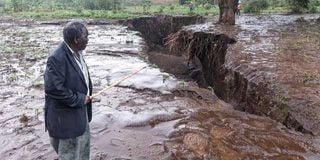Nature's fury: Fissure literally splits Nakuru village

Mr Kimiricho Nyaikiru at the fissure in Nyatoro, Nakuru County on Sunday.
Residents in Mukuru wa Nyatoro, in Kiambogo, Nakuru County are on the edge after waking up recently to find their farms split by fissures.
At first, their farms had cracks, which – following more rains – widened to ditches. Smoke started billowing from the beneath the surface.
That is when they knew something was amiss. Then came tremors and sounds of crashing on Friday night. Few dared to move out of their houses.
It was the following morning on Saturday that they became aware of what had happened.
The ditches had been transformed to fissure a measuring several metres apart and as deep as 13 metres spread over a kilometre.
The tremors and sounds were actually coming from the earth splitting and debris falling into the newly formed holes.
Surprisingly, the gullies have an appetite for rain water, which despite flowing into them, somehow disappear through minute channels on the surface.
Ms Priscilla Nthenya, 69, has never witnessed the phenomenon and is gravely concerned as some of the faultlines are under her house.
“I have not slept since this happened. I sit on the sofa every night praying for my house not to be swallowed. Government officials are telling us to move but where do we go? This is the only place I know?” the sobbing mother of four asked rhetorically.
The widow takes care of her grandchild and a few cows and goats at her one-acre piece in Kiambogo. Her children have moved to towns in search of employment.
“Why is the government not coming to our rescue? Must someone die or houses be swallowed for them to rush here with food and other items? That is what families here need now,” she said.
Her plot is next to Mr Moses Thuo’s farm, which bore the worst brunt of the split. Mr Thuo’s farm has the widest crack.
So serious is the situation that some parts of the farm were still falling into the new gulley as he took the Daily Nation crew around.
A gigantic tree, estimated by locals to be almost a century old, stood on the edge of the gulley, some of its massive roots suspended in the air.
“I have lost investments valued at hundreds of thousands of shillings. My sugarcane and banana plantations have vanished. The entire farm is covered by silt and debris being deposited by the rain water,” Mr Thuo said.
“I cannot sell this piece of land even if I want to. Who will buy it?”
More than two acres of his land is under mounds of silt. The farm also has wide trenches channelling rain water into the gulley.
“We are afraid as nobody understands what is happening. I have lived in Kiambogo since 1984 and the worst I have witnessed are landslides,” he said.
“We also don’t know where this water is going.”
Mr Kimiricho Nyaikuru, an elder and the area chairman, said this year’s rainfall exceeds what he has witnessed in the past.
Mr Nyaikuru was the first figure of authority to be informed of the fissures. He promptly reported it to the area chief.
Luckily, no life has been lost, a police officer said. The chief was not at his office when the Daily Nation team arrived.
Ms Grace Akinyi, a geologist, said increased water flow during rains can erode weak points in the earth’s crust, causing faultlines to widen and form rifts or fissures.
“Kiambogo is in an area experiencing tectonic activities and movements,” she said.





